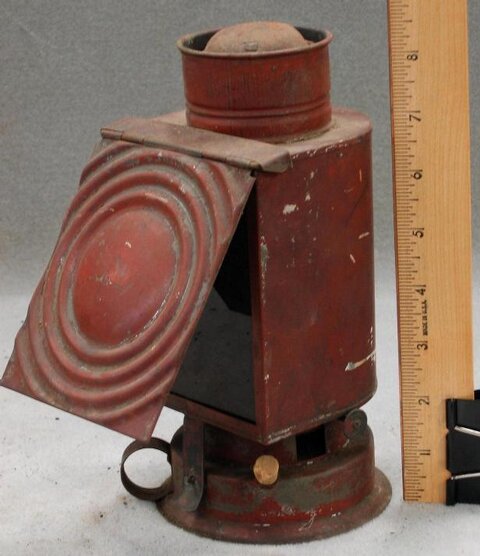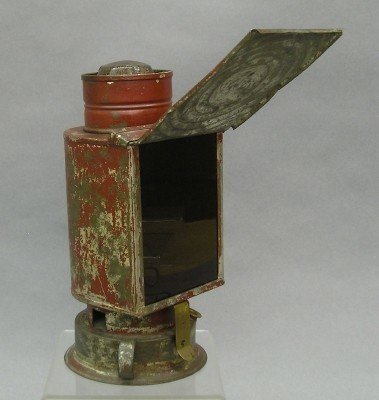Believe I'm up to 157 vintage lighting fixtures in collection now, 117 I own which isn't a bad insurance policy given an average of at least $100.00 per fixture worth in a rough average of what I have. Still yet to work on the Lobser wheel and other accessories are not included in that figure.
Was bad in buying three new fixtures so far this year on the cheap - of course shipping always kills of the cheap, but I think them cool in the "smalls" easier to gain more of than the larger ones. One often thinks bigger is better and yea, I have my various 8" Leko cross cannons about, but for me at last I have the main bulk collection and at this point while waiting for some trades on duplicates or shop gear in exchange for stuff I don't have, bulking up on the cheep allows for more variety.
Looking for more info on the following three fixtures (first on the list on the way and looks to be without need of any work.)
MANHATTAN OPTICAL CO. ANTIQUE OIL LAMP POSSIBLY PHOTOGRAP... (161001333465) Manhattan Optical Co Antique Oil Lamp Possibly Photographic or Stage Set Light | eBay
Was fairly cheap and potentially something turn of the century and could have been in use say a foot light. Any knowledge of what type of fuel it was using and history about it?
ANTIQUE STAGE SPOT LIGHT (321094840900) Antique Stage Spot Light | eBay
It's probably not a stage light and it was an A-19 medium screw lamp inside it with a totally trashed/broken lamp socket and siezed switch - all that isn't fixable. That plus the lens is not able to be replaced, still on small fixtures collection, I often buy on the style factor. Brand, use and date? that I don't yet know other than the clamp seems to be able to clamp down on something from 2" wide and smaller and had a felt liner on it.
Best find:
VINTAGE STAGE / PHOTO LIGHT (350721643586) Vintage Stage Photo Light | eBay
I think this is a box spot from about 1903 thru 1910. Think this because I already have a 4.1/2" lens version of it in how it was assembled and how the rear cover slides into place instead of being hinged. A G-30 lamp normal to a box spot won't fit into this narrow fixture, has to have been using a pre-nitrogen gas added 100 Watt vaccume lamp from that period. Gel frame is gel secured between the front plates in perhaps pre-the idea of a gel frame slot. Other than a bunch light, (and the obvious strip lights) this box light might be one of the eldest filament lamp type fixtures I am thinking but cannot confirm.
P.S., the lamp came broken on that this fixture - a shame because will have been interesting to see what it was.
Was bad in buying three new fixtures so far this year on the cheap - of course shipping always kills of the cheap, but I think them cool in the "smalls" easier to gain more of than the larger ones. One often thinks bigger is better and yea, I have my various 8" Leko cross cannons about, but for me at last I have the main bulk collection and at this point while waiting for some trades on duplicates or shop gear in exchange for stuff I don't have, bulking up on the cheep allows for more variety.
Looking for more info on the following three fixtures (first on the list on the way and looks to be without need of any work.)
MANHATTAN OPTICAL CO. ANTIQUE OIL LAMP POSSIBLY PHOTOGRAP... (161001333465) Manhattan Optical Co Antique Oil Lamp Possibly Photographic or Stage Set Light | eBay
Was fairly cheap and potentially something turn of the century and could have been in use say a foot light. Any knowledge of what type of fuel it was using and history about it?
ANTIQUE STAGE SPOT LIGHT (321094840900) Antique Stage Spot Light | eBay
It's probably not a stage light and it was an A-19 medium screw lamp inside it with a totally trashed/broken lamp socket and siezed switch - all that isn't fixable. That plus the lens is not able to be replaced, still on small fixtures collection, I often buy on the style factor. Brand, use and date? that I don't yet know other than the clamp seems to be able to clamp down on something from 2" wide and smaller and had a felt liner on it.
Best find:
VINTAGE STAGE / PHOTO LIGHT (350721643586) Vintage Stage Photo Light | eBay
I think this is a box spot from about 1903 thru 1910. Think this because I already have a 4.1/2" lens version of it in how it was assembled and how the rear cover slides into place instead of being hinged. A G-30 lamp normal to a box spot won't fit into this narrow fixture, has to have been using a pre-nitrogen gas added 100 Watt vaccume lamp from that period. Gel frame is gel secured between the front plates in perhaps pre-the idea of a gel frame slot. Other than a bunch light, (and the obvious strip lights) this box light might be one of the eldest filament lamp type fixtures I am thinking but cannot confirm.
P.S., the lamp came broken on that this fixture - a shame because will have been interesting to see what it was.
Last edited:




